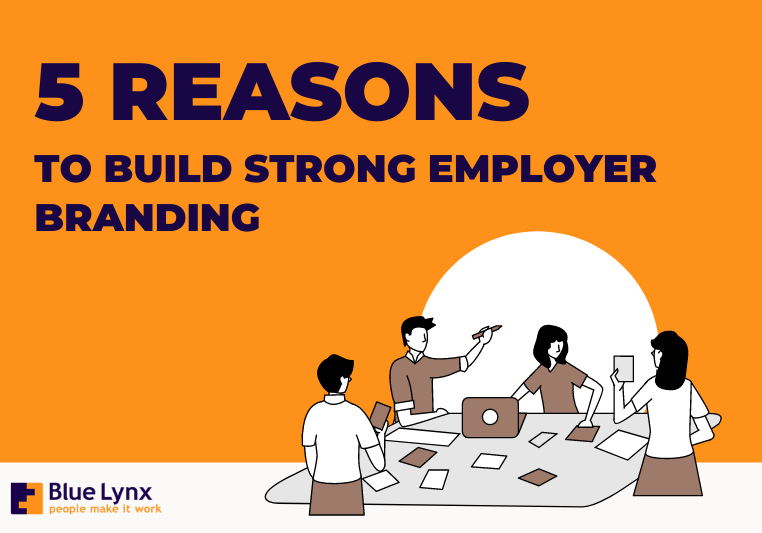It’s common for Dutch employers to ask for a cover letter as part of the job application process. When that’s the case, it’s important to make it as good as your CV. But, even if it’s not a job application requirement, you might want to include a cover letter anyway. It never hurts to show your motivation to a potential employer.
Are you stressing out about how to write a good cover letter? Not sure what to include or how to format it? No need to worry. The Blue Lynx team of international recruiters knows what a good cover letter looks like. After reading this article, you will do too.
So, let’s dive in! Learn about cover letter structure, good and bad practices and how to write yours well. Oh, and there is a cover letter example towards the end so keep reading.
Short on time? Skip to the most important bits of this article:
- Standard Structure of a Cover Letter (+ a free downloadable cover letter template)
- 3 Golden Rules for Cover Letters
- Good and Bad Cover Letter Writing Practices
- A Cover Letter Example and Analysis
We could give you the usual tips and tricks here, but we’ll let you in on a little secret instead. You don’t have to be an immaculate writer to craft a great cover letter. You just need to know to structure your thoughts and present your skills and achievements in the best light possible.
Now, we didn’t say it was easy but we believe anyone could do it. Writing a cover letter could take up a few days so we recommend you bookmark this article for future reference.
What Is a Cover Letter?
A cover letter is a one-page document that you send to a prospective employer when applying for a job. The purpose of a cover letter is to relate your unique experience and achievements to the job you are applying for while showcasing your motivation to work for the company. Of course, in the digital world that we live in, you don’t have to actually mail a physical letter. It usually goes hand-in-hand with your CV as part of an online job application.
Letter of Motivation vs Cover Letter: What Is the Difference
After spending some time in the job searching process, you might start seeing it with different names.
A letter of motivation, a covering letter, a motivation letter. So many titles. But is it the same thing?
The Dutch word for it ‘motivatiebrief’ [pronounced mo-tee-va’-tee-eh brief] can mean any of those. You can encounter them in the context of both a job and university application. Here we will focus on the motivatiebrief for job vacancies.
The Standard Structure of the Cover Letter
Let’s start with the nitty-gritty of cover letter writing. First things first – the layout. It’s a good practice to have the same design for both your CV and cover letter. This includes fonts, colours, and formatting.
In terms of structure, a standard cover letter should include:
- Personal information and contact details
- A formal salutation (Dear Hiring Manager or the person’s name)
- Introduction paragraph (clearly stating the job you are applying for and the company)
- Main body with 2-3 paragraphs
- Closing paragraph
- Formal letter signature
Cover Letter Writing: The Before, During & After
If you like having a plan before sitting down to write the cover letter, we suggest you use the steps outlined below.
1) Before You Start Writing
Study the job description – you need to know exactly what the company is looking for. Look for information about the day-to-day tasks in this role and the profile of the successful candidate.
Make a list – You have done your research. You know exactly who and what the company needs. Now take a minute to look at all the requirements or skills the job mentions and list down the ones you match. Once you have all those down, write your cover letter following the formula: Skill -> Example -> Achievement.
Every time you mention you have a certain skill or experience, give an example of it and tie it up with a personal achievement in that area. Your cover letter will end up sounding way more convincing.
Research the company – go on their website and find out what exactly they do, who they are serving, and what their values are. Use your finding in the cover letter. It will leave a great impression.
2) While Writing the Cover Letter
Make an outline of what you will include – follow the layout we gave you above. Each paragraph should be about 3-4 sentences long.
Choose an easy-to-read professional font – looks matter. Keep your cover letter in the same colour grade and design as your CV if possible. Use consistent fonts that are easy on the eye of the reader.
Keep sentences short – have you heard of the writing technique “KISS”? It stands for Keep It Simple, Stupid. Most people try to sound smart in their writing and get lost in long, tedious sentences. You don’t want to do that.
3) When You Finish Writing
Check for grammar, spelling and punctuation – use a tool that will automatically check those for you like Grammarly.
Read it out loud – this really helps you spot inconsistencies and a lack of good flow.
Ask a friend to proofread it – it’s always good to have an unbiased person look at your cover letter and give you some feedback.
If you need some serious inspiration or don’t know how to write your cover letter, we have a quick and easy-to-use solution: a free cover letter template. Click the link below to download it.
Download Our Free Cover Letter Template
Now that we have the basic structure down, let’s move to the content. Whether you use our cover letter template or come up with your own, it’s what you say in it that matters. Cover letters are brief and concise. One page is the go-to length here.
3 Golden Rules for Writing a Good Cover Letter:
- Make it personal – ditch the usual phrases
- Your cover letter should be a natural extension of your CV, not a re-write
- Showcase your knowledge of the company
If you manage to follow these 3 rules, your cover letter will undoubtedly make a good impression. Now let’s look at some more practices.
Writing the Cover Letter: The Good Practices & Things You Should Avoid
The Good
In addition to the 3 golden rules from above, you will also want to do the following:
Focus on key skills
Work experience is important. But what’s more important is that you can extract the hard and soft skills you have gained through it. This should be the focus of the cover letter’s main body. Think about the type of skills this job requires. Find examples in your work experience that support your statement.
Show real motivation
If the employer requests that you write a letter of motivation, then you need to demonstrate your passion. Show that you know the company’s values and that you are truly motivated by its mission. This is not just a way to stroke your potential employer’s ego. It shows you know what the company stands for.
Share relocation details
If you don’t live in the country or in the city where the job is based, it’s good to mention your relocation plans.
The Bad
These are the don’ts of writing a cover letter that job seekers should keep in mind. These are pitfalls one can easily miss.
Cover letter sounding way too vague
Some people struggle with writing, in general. For them especially, it’s easy to use cliché and vague expressions. Think sentences like “I admire your company’s great reputation in the industry.” This could be copied and pasted across all your cover letters. Be more specific and use actual examples of what’s so great about the company.
Re-writing your CV
One thing a cover letter is not is your CV. It may seem obvious, but many people don’t get that. Instead of listing all your work experience, write about what it has taught you. Then, relate all that to the position you are applying for.
Typos and bad formatting
Just like with your CV, the devil is in the details. Typos and grammar errors leave a bad impression. You want to demonstrate a good eye for detail. Ask a friend or a family member to proofread your cover letter before sending it out.
The Ugly
There are some bigger fails when it comes to writing a cover letter. Do your best to avoid those:
Putting the wrong company name
We’ve seen those and we cringe every time. Such mistakes usually happen when you are using the same cover letter template for every job application. To avoid this, tailor the text to each employer individually.
The cover letter is too long
Needless to say, hiring managers’ time is limited. They won’t spend ages on your cover letter, so everything you put inside must be well-thought and engaging. You don’t want to bore the people reading about your experience. You want to say just enough so that they want to invite you to an interview and get to know you further.
Lying
No matter what you do, don’t lie on your cover (in your CV, as well). You won’t be doing yourself any favour, even if you get hired.
Here’s a Cover Letter Example That We Can Learn From
“To Whom It May Concern:
I am a driven and keen individual looking to work within the field of ____. However, the world is currently giving me a gigantic middle finger in terms of employment prospects; so I’m hoping to offer my services to the place I’ve probably spent one third of my time in since moving to _____. Despite having attended university, I assure you I’m possessed of a wide range of useful skills;
- I have worked as a nursery hand at ___ am an avid gardener, along with a scientific understanding of soil and plant ecology, and a familiarity with a wide range of plant species.
- I have my own vehicle, and am available at any time for any length.
- Between myself and my father, I have an almost encyclopaedic understanding of the store layout.
- Being raised by an Engineer and industrial arts teacher, I have a moderate understanding of common building materials and basic requirements, including the difference between gyprock and wood screws, and the joy of PVA. I’ve completed numerous DIY projects of varying scales, from garden construction to household fixes and shelving, and can offer basic advice.
- I’m a creative thinker, and am good at visualising solutions to unique problems, which could be useful both in-store and to customers.
- I have a natural space bubble of around 2 metres, so will not struggle with maintaining social distance.
- I have undergone military training and over a decade in retail, and as such respond appropriately and calmly to hostile treatment. I can even bayonet them if need be, and my grouping isn’t had either.
- I maintain a combat-ready level of fitness, and am more than capable of strenuous physical activity that pallet-jacking and shelf-stocking may involve.
- I have developed excellent interpersonal skills during my various stabs at careers, and understand the need for tailored and sensible approach in successful professional interactions. As an avid baker, I’m also great for team morale.
- I’m 30, friendless and childless, so am statistically unlikely to call in sick due to hangovers.
While I will jump ship the moment I receive an offer applicable to my chosen career path, you shouldn’t worry about that being too soon, as I’ve job-hunting since October, and that was before this ship floated sideways. I will work hard and be an asset.”
Source: Reddit.
In this cover letter example, we can clearly see some of the dos and don’ts we discussed above. So, let’s analyse it! Just for the record, we are not going to focus on punctuation, spelling, and grammar. You can easily check those with writing software like Grammarly. Instead, let’s talk about what this person did right and what they could have done better. We’ve summed it up in the table below.
| Good cover letter practices | What to improve/avoid |
| Making it very personal, tell a story | The use of foul language |
| Backing hard and soft skills by referencing relevant experience | Not showing enough motivation to work in this particular company |
| Using honesty and a sense of humour | Being too honest (“I would jump ship for a better offer”) |
| Showing a good understanding of specific requirements | Showing that you are super desperate to get the job (“I’ve been job hunting for months”) |
Your Turn to Write a Fantastic Cover Letter
Follow all these tips and you should have the perfect cover letter in your hand (or in a computer folder). Now what? As good as they might be, a CV and a cover letter can’t get you the job. You still have the interview process. If you are feeling a bit nervous, check out our job interview tips for some inspiration.





![Education vs. experience [Title] Job requirements: Education vs. experience](https://bluelynxcareers.bg/wp-content/uploads/bb-plugin/cache/Job-requirements-education-vs-experience-landscape-1ec43d95a48ad704bd7217ec829c042f-.png)


![Unlocking the Connection between Sleep, Work, and Productivity The Importance of Quality Rest for Optimal Performance [Title] Unlocking the Connection between Sleep, Work, and Productivity The Importance of Quality Rest for Optimal Performance](https://bluelynxcareers.bg/wp-content/uploads/bb-plugin/cache/Unlocking-the-Connection-between-Sleep-Work-and-Productivity-The-Importance-of-Quality-Rest-for-Optimal-Performance-landscape-2b91ccd746800d863e8c65276c6876c9-.png)
![Attracting Talent and Driving Innovation The Role of Sustainability in Modern Business [Headline] Attracting Talent and Driving Innovation The Role of Sustainability in Modern Business [Headline]](https://bluelynxcareers.bg/wp-content/uploads/bb-plugin/cache/Attracting-Talent-and-Driving-Innovation-The-Role-of-Sustainability-in-Modern-Business-landscape-7f26c9342f1650800e5633d1b4424d68-.png)

![Toxic productivity [Title] Toxic productivity](https://bluelynxcareers.bg/wp-content/uploads/bb-plugin/cache/Toxic-productivity-landscape-ce165975805cbbc4b58e4c23cf758014-.png)